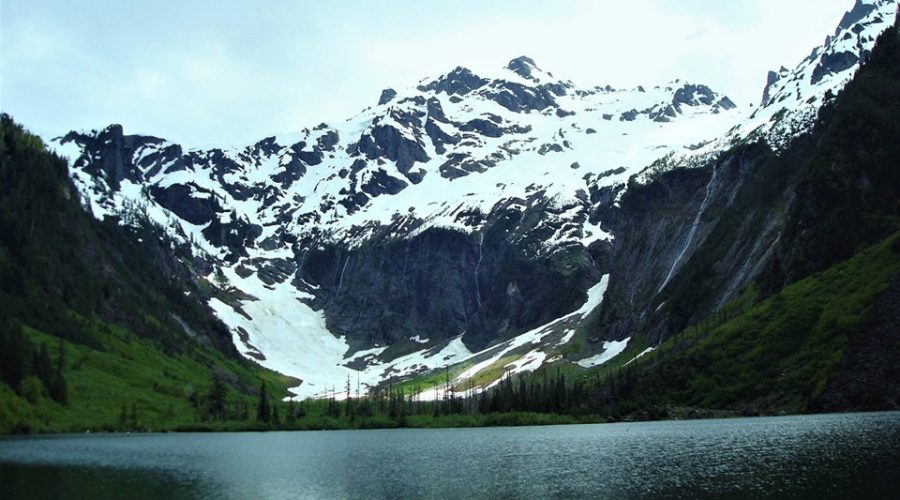
The History Of Goat Lake & Penn Mining
When gold was discovered in the Cascade Mountains, it came with the usual lofty dreams of mineral wealth. One of these stories involves the lovely alpine destination known as Goat Lake. In 1891, Henry Cochran, Del Bishop and Jerome Coffin, staked a mining claim near an alpine lake, a place the Sauk-Suiattle natives called “Sweelie Hatchu”. The miners excitedly reported that the whole valley was streaked with ore, and soon prospectors began flooding the area.
All of this activity got the attention of a wealthy mining company in Pennsylvania, the Penn Mining Company. By 1895 a seven mile puncheon road was connected with the Monte Cristo Pioneer Road up to the lake which was now dubbed Goat Lake because of the abundance of these spritely animals along the surrounding slopes. The first mining camps were located about halfway up the north side of Cadet Peak by its namesake, the Cadet Mining Company, and another was located on the south side of Elliott Creek about a half mile below the lake’s outlet. Penn Mining Company focused their attention on Foggy Peak, on the south end of the lake. Utilizing binoculars today one can still see the old tunnel of Wild Goat Lode.
The first Penn Mining office was located on the knoll northeast of the lake, but was swept into the lake by an avalanche, so a second office was built along the northern shore. A portion of this three story building operated as a hotel run by the McIntosh family. The 300 foot waterfall at Goat Lake’s drainage forming Elliott Creek is named after a family member.
Penn Mining Company also built several structures including a sawmill, blacksmith shop, a fancy home for their foreman, Jim Sloan, and several cabins. They opened nine mining tunnels on Foggy Peak; Lizzy Load, August Lode, Penn 95 Lode, New York Lode, Foggy Lode, Little Joe Lode, Alamo Lode, Benja Lode and Wild Goat Lode. On Ida Pass, which is named after a dance hall girl at Monte Cristo, two more tunnels were added, the 92 Lode and Ida Lode. The overall plan was to collect and transport ore by tram, barge it across the lake, load it into wagons, bring it down to the road, then get it to the processor.
It is unclear when the buildings were vacated but because the hotel stood for decades it was just referred to as the Hotel at Goat Lake. According to Forest Service Ranger Harold Engles, these buildings stood for many years untouched and often utilized by the occasional hiker seeking shelter. The tram could still be seen in the 1950s but was completely collapsed to the ground some time during the 1960s. At one time the settlement spanned both sides of Elliott Creek with the large log office/hotel and several cabins to the north and several more cabins, blacksmith shop and sawmill on the south. There was a even a bridge spanning Elliott Creek connecting both sides of the settlement.
Author Bob Heirman Shares his recollections of Goat Lake in his book “Snohomish My Beloved County, An Angler’s Anthology.” In it he describes his fishing partner Henry Grill receiving a rather unique birthday gift. It seems that Henry’s older brother Leslie presented him the deed for a 5 acre piece of wilderness land adjacent to Goat Lake known as the Lizzie Mill Site. So, sometime in 1958 Henry and Bob set out to have a look at this piece of land. To their surprise there stood several buildings and a massive log lodge. He explains; “It was as if entering a time machine, Henry and I stood in yesteryear.” The blacksmith shop was still intact, the foreman’s home… was beginning to sag but they could still enter and see the beautiful Roman brick fireplace. Crossing the creek and heading north they came to the old office and hotel. Bob describes it like this; “The lodge of log construction was three stories high and had a tin roof.”
So what happened to the town? In spite of the many tunnels developed on Foggy peak, that elusive rich vein of gold was never discovered. According to the mineral survey, Penn Mining did produce lead, silver and zinc with a by-product of gold. In the 1960s a landslide damaged a good portion of the old town to the north, and the Forest Service, not realizing the remaining old buildings were on private land, burned the old lodge to the ground some time in the 1960s.
When you hike into Goat Lake you will see the remains of the puncheon road where the bridge used to cross over to the southern part of the settlement. When you reach the lake you will come to a flat area in the forest where there are two wilderness toilets and camping is allowed. This is where the old Penn Mining Office and Hotel once stood. There are still some charred timbers to the north of this area, a remnant of that fateful day when the old hotel was burned.
Looking Back At The Penn Mining Days
Sources:
- Pioneer Harold Engles
- Interview with Author Bob Hierman, and his book, Snohomish My Beloved County, An Angler’s Anthology
- Author, Nels Bruseth, Indian Stories and Legends of the Stillaguamish, Sauks and Allied Tribes